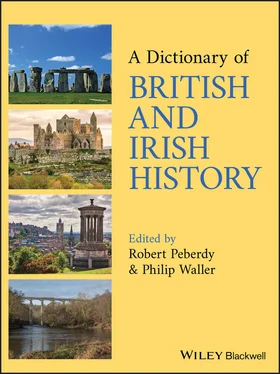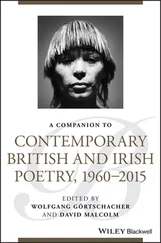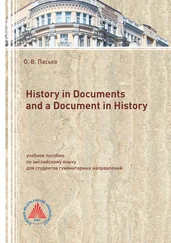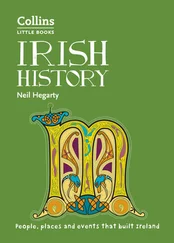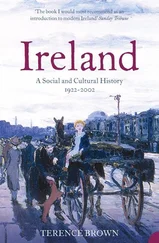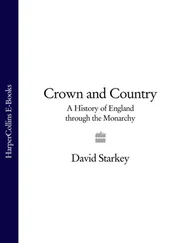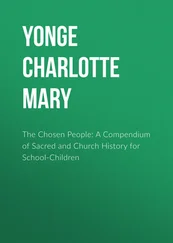By the mid 1920s, domestic banking was dominated by a ‘big five’: Barclays, Lloyds, Midland, National Provincial, Westminster. The last two merged in 1968 (renamed ‘National Westminster’ 1970; acquired by Royal Bank of Scotland 2000); Midland was bought by the Hongkong and Shanghai Banking Corporation in 1992. From the 1980s some building societies became banks, increasing competition. In 2009, following a crisis, the British government acquired majority ownership of Royal Bank of Scotland and part‐ownership of Lloyds (latter terminated 2017). See also BANKING, SCOTLAND; CURRENCY, ENGLAND AND GREAT BRITAIN FROM 1660S.
BANKING, IRELAND
Banks were started from the 1720s (six in DUBLIN by 1730s). They were usually operated by merchants, who bought bills of exchange (thereby providing capital), transmitted money and issued notes. Economic crises usually resulted in bank collapses.
In 1782, supported by PATRIOTS, Parliament founded the Bank of Ireland (opened 1783), and encouraged its pre‐eminence by limiting other note‐issuing banks to six business partners. Following a crisis in 1820, the Bank of Ireland Act (1821) permitted joint‐stock banks with unlimited partners over 50 (Irish) mi (100 km) from Dublin. New banks included the Hibernian Bank (1825) and Ulster Bank (1836). The Bank of Ireland acted as a central bank in assisting other banks. The 1845 Bank Act limited note issuing to six banks. By 1914, about 860 bank branches existed. During the 19th century SAVINGS BANKS and building societies were also formed.
Co‐operation between banks from the later 19th century culminated in the Irish Banks’ Standing Committee formed by nine banks in 1920. Co‐ordination continued despite the PARTITION OF IRELAND (1921). Suspicion of banks caused the IRISH FREE STATE government to undertake investigations (1926, 1934–8) and found State‐sponsored credit providers. IFS banks maintained close relations with the Bank of England until WORLD WAR II, when an Irish Central Bank was created (1942).
Mergers in the 1950–60s left four main banks: Bank of Ireland and Allied Irish Banks based in the Republic of Ireland; Northern Bank and Ulster Bank based in Northern Ireland (subsidiaries of British banks). Rapid expansion of lending from the later 20th century left many banks and other financial institutions potentially insolvent when a financial crisis erupted in 2008. The Republic’s government was forced to guarantee deposits and nationalize companies, including Anglo‐Irish Bank, Allied Irish Banks and Bank of Ireland. See also CURRENCY, IRELAND FROM 16TH CENTURY.
BANKING, SCOTLAND
The first bank, the Bank of Scotland (in EDINBURGH), was incorporated by Scotland’s Parliament in 1695 with a 21‐year monopoly. Its purpose was to encourage commerce by expanding credit (gold and silver coins were scarce). It discounted bills, lent money, and from 1704 issued notes. Two similar banks followed (founded by royal charter): Royal Bank of Scotland (1727) and British Linen Company (1746), the latter to promote the linen industry but which specialized in banking and pioneered a branch network. From 1747 banks were also founded in provincial centres, notably GLASGOW. Financed mainly by merchants, they provided services for trade, agriculture and industry, including cash accounts (overdrafts), deposit accounts, and note issuing. (Parliament’s prohibition on joint‐stock companies in 1720 was not applied in Scotland.) By 1826 there were 36 banks. In 1810 Henry Duncan, minister of Ruthwell (Dumfriesshire), founded a parish savings bank for the poor. His idea spread: by 1818 there were 182 such banks ( see SAVINGS BANKS).
In the 1840s restrictive legislation halted expansion and encouraged conservatism: the 1844 Bank Charter Act effectively prevented new banks from issuing notes; from 1845 note issuing beyond an authorized amount had to be backed by specie. Crashes (e.g., large Western Bank in 1857) and amalgamations reduced numbers: to ten by 1878, eight by 1914, five by 1958, three by 1971 (Bank of Scotland, Royal Bank of Scotland, Clydesdale Bank, founded 1838 and owned by Midland Bank since 1920). Categorized from 1971 as ‘clearing banks', in the 1970s–90s they developed business both within and outside Scotland.
From the late 1990s Royal Bank of Scotland expanded rapidly, briefly becoming the world’s largest bank, and in 2001 Bank of Scotland merged with Halifax Building Society as HBOS. But in 2008 both faced collapse. The former was taken largely into government ownership, and the latter was acquired by Lloyds (2009) with government support. See also CURRENCY, SCOTLAND.
BANKING SCHOOLsee CURRENCY SCHOOL BANK OF ENGLAND
Originally a JOINT‐STOCK COMPANY incorporated in 1694 by royal charter, comprising subscribers to a £1.2 million loan to the English government (for funding the War of the GRAND ALLIANCE). Enlarged from 1696, the Bank became the government’s main source of short‐term loans and its own bank (e.g., holding balances, providing bullion for CURRENCY), and also London’s leading bank. It enjoyed a monopoly of joint‐stock banking in England and Wales (1697–1826), was the leading issuer of notes, discounted bills of exchange (contracts for payments), and provided accounts to other banks. From 1763 (financial crisis), it was regarded as ‘lender of last resort’. Its support for other banks gave it considerable influence, a situation enhanced from 1797 when convertibility of its notes into gold was suspended, compelling other banks to hold its notes as reserves.
When convertibility was restored in 1821, the Bank operated the GOLD STANDARD to encourage economic stability. After a financial crisis in 1825, it opened provincial branches to improve the distribution of notes and sovereigns. Crises in 1836 and 1839 resulted in the BANK CHARTER ACT (1844) which encouraged a monopoly in England and Wales for Bank of England notes, and regulated note issue. The Bank was now effectively a British ‘central bank’. A liaison committee with other banks was formally established in 1911. In the later 19th and early 20th centuries the Bank exerted influence internationally through London’s world pre‐eminence as a financial centre.
Following suspension of convertibility in 1919 (after WORLD WAR I), the gold standard was restored in 1925, only to be abandoned in 1931. Nationalization of the Bank (1 March 1946) enabled central government from the 1950s to use the BANK RATE for its monetary policy. Control was redelegated to the Bank in 1997, though another authority undertook supervision of banks and insurance companies (restored 2013). See also FINANCIAL REVOLUTION; BANKING, ENGLAND AND WALES.
BANK OF IRELANDsee BANKING, IRELAND BANK OF SCOTLANDsee BANKING, SCOTLAND BANK RATEOriginally the ‘discount rate’ of the BANK OF ENGLAND (for discounting bills of exchange, 18th–19th centuries), normally above other rates. From the 1860s to 1930s it protected gold and other UK reserves (by attracting inflows at a high interest rate), and from the 1950s was part of government monetary policy (influencing commercial interest rates and general economic activity). Replaced Oct. 1972 by ‘minimum lending rate’, to encourage competition among banks. See also GOLD STANDARD. BANKS, JOSEPH
(b. 13 Feb. 1743 at London, England; d. 19 June 1820 at Isleworth, Middlesex, England, aged 77). Interested in botany from school days, Banks attended OXFORD University. The inheritance of an estate soon afterwards (1764) enabled him to pursue natural history. Encouraged by Daniel Solander, a follower of the Swedish botanist Linnaeus, Banks participated in three overseas expeditions as a naturalist: to NEWFOUNDLAND and Labrador (1766), around the world with James COOK (1768–71), and to Iceland (1772). In 1766 he was elected a fellow of the ROYAL SOCIETY.
Читать дальше
